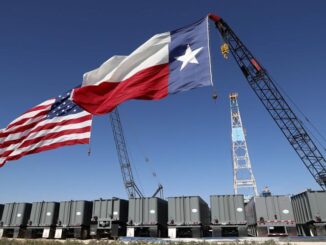
NYMEX front-month natural gas futures have seen some significant upside action in recent days, with prices climbing back above $8.00/MMBtu — highs that haven’t been seen since about mid-June. After hitting an intraday high of $8.176/MMBtu on July 21, profit-taking emerged, and the August gas contract lost 7.5 cents to settle at $7.932/MMBtu.
The early price strength stemmed from a bullish weekly gas storage data report from the Energy Information Administration, which showed a much smaller than projected storage build. At least a portion of the bearish storage data could be attributed to a surge in nonlinear demand as some utilities were tasked with starting up older, inefficient gas turbines to meet exceptionally high demand for cooling amid widespread heat.
The EIA reported a 32 Bcf injection, bringing working gas in storage to a total of 2,401 Bcf for the week ended July 15. This storage data was considered bullish as most market players anticipated a build ranging from roughly 35 Bcf to as much as 48 Bcf. According to the EIA, gas inventories were 270 Bcf less than last year at this time and 328 Bcf below the five-year average of 2,729 Bcf. In taking an advance look at the next EIA gas storage report for the week ending July 22, preliminary market projections are for a build ranging from as little as 25 Bcf to as much as 39 Bcf.
A notable jump in price volatility has also been a recent theme. The volatility in NYMEX gas futures has been influenced by the combination of below-average storage inventories, wobbling dry gas production, unseasonably cold temperatures late last winter, followed by the current torridly hot summer temperatures across the US. On top of this came the Ukraine-Russia war and the closure of the Freeport LNG export terminal.
Summer’s peak
There seems little to temper the heightened volatility in the near future. Gas market bears are pointing to the fact that the summer heat is currently at its seasonal peak, and temperatures will soon be moving to the downside of the bell curve. While dry gas volumes are having difficulty finding consistent upside traction, the trend is indeed higher, and it appears likely that even more dry gas volumes will be coming online over the next few months.
Additionally, the 2022 hurricane season appears poised to become very active in the weeks ahead. The forecast services are anticipating a very active season, which could elevate the risk for LNG export facilities along the Gulf coast. Meanwhile, the longer-range weather forecast models already hint at the potential for a warmer than normal first half of the 2022-23 winter.
Lastly, with higher prices, the economic fallout from high-priced demand destruction could also play a role in producing lower overall demand, especially in light of rocketing inflation in other forms of energy, food, housing, and rising interest rates. Once the summer heat finally relents in the weeks ahead, all of these bearish price-setting mechanisms could combine forces to inject some downside pressure on NYMEX gas futures, which could return to the $5.40s/MMBtu or lower. This price level was last seen less than a month ago, in early July.
Source: Spglobal.com



